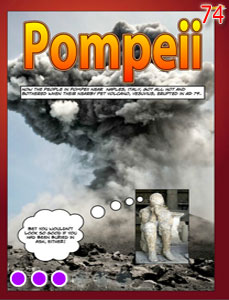Explore these further resources...
(These links take you to other parts of our web site, never to outside locations.)
You can search in these books:




On the 24th of August 79AD, Mount Vesuvius erupted with such violence that the top of the volcano was blown away.
Some of the fiery ash, gas and steam produced buried Pompeii 3m deep, while nearby Herculaneum was buried under 25m. The ash came out of the volcano at 1.5 million tonnes a second! About 16,000 people were killed in the eruption, of which a few dozen bodies were perfectly preserved in the ash. The ash buried and preserved the city for over 1500 years until it was dug up by archaeologists.
During the eruption a column of gas, ash and steam was thrown into the air, creating what looked like a mushroom cloud. The ash may have reached over 30 km into the sky before falling back to the ground. This cloud continue to 'rain' ash for about 18 hours. Buildings started to collapse under the weight of the ash, and some people began to escape. But then came a quite different event: a deathly blast of high temperature, high speed gases and dust. Nowadays we would call it a glowing avalanche. Anyone left simply died from the heat or they were suffocated in the fumes, and were then buried by the falling ash.
A Roman called Pliny the Younger saw this from about 18km away and experienced some of the effects of earthquakes and falling ash. Those who remained in Pompeii were so close to the volcano they stood little chance.
"On 24 August, in the early afternoon, my mother drew my uncle's attention to a cloud of unusual size and appearance. It rose to a great height on a sort of trunk and then split off into branches. In places it looked white, elsewhere blotched and dirty, according to the amount of soil and ashes it carried with it.
My uncle, who was in charge of the Roman fleet in the bay, hurriedly steered his course straight for the danger zone to rescue people. He was entirely fearless. Ashes were already falling, hotter and thicker as the ships drew near. I never saw my uncle again.
People near me argued whether to stay indoors or take their chance in the open, for the buildings were now shaking with violent shocks. Outside, on the other hand, there was the danger of falling pumice stones. As a protection against falling objects they put pillows on their heads tied down with cloths."


